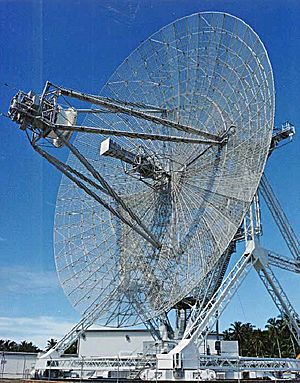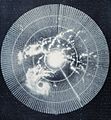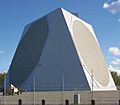Radar facts for kids
Radar is a machine that uses radio waves for echolocation to find objects such as aircraft, ships, and rain.
The basic parts of a radar are:
- The transmitter creates the radio waves.
- The antenna directs the radio waves.
- The receiver measures the waves which are bounced back by the object.
By doing this, the radar can locate the object. Radar is used in many different ways. It can measure the speed and number of cars on a road, the amount of water in the air, and many other things.
Radar was first used in 1904 by Christian Hülsmeyer. He was given a patent for radar (Reichspatent Nr. 165546). It became commonplace during World War II.
The word RADAR was created in 1942 as an acronym for Radio Detection and Ranging. This acronym replaced the British initialism RDF (Radio Direction Finding). The word is now thought of by many people as a regular word, no longer as an acronym.
The FAA (Federal Aviation Administration) use several kinds of radar:
- ARSR (Air Route Surveillance Radar)
- ASR (Airport Surveillance Radar)
- ASDE (Airport Surface Detection Equipment)
- TDWR (Terminal Doppler Weather Radar)
- PAR (Precision Approach Radar)
Images for kids
-
Experimental radar antenna, US Naval Research Laboratory, Anacostia, D. C., from the late 1930s (photo taken in 1945).
-
The first workable unit built by Robert Watson-Watt and his team
-
A Chain Home tower in Great Baddow, Essex, United Kingdom
-
Brightness can indicate reflectivity as in this 1960 weather radar image (of Hurricane Abby). The radar's frequency, pulse form, polarization, signal processing, and antenna determine what it can observe.
-
Pulse-Doppler signal processing. The Range Sample axis represents individual samples taken in between each transmit pulse. The Range Interval axis represents each successive transmit pulse interval during which samples are taken. The Fast Fourier Transform process converts time-domain samples into frequency domain spectra. This is sometimes called the bed of nails.
See also
 In Spanish: Radar para niños
In Spanish: Radar para niños














